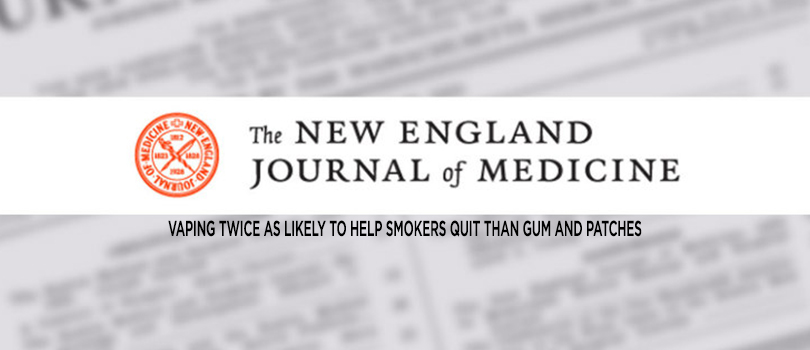
E-Cigarettes are twice as likely to help smokers quit than gum and patches, a claim made in a major new study just released in the New England Medical Journal. While this information is not necessarily news to millions of vapers around the world who have used this technology to end combustible Tobacco dependence, this study has hit American headlines like nothing before it.
About the Study
During the UK based study, they randomly assigned adults attending U.K. National Health Service stop-smoking services to either nicotine-replacement products of their choice, including product combinations, provided for up to 3 months, or an e-cigarette starter pack (a second-generation refillable e-cigarette with one bottle of nicotine e-liquid [18 mg per milliliter]), with a recommendation to purchase further e-liquids of the flavor and strength of their choice. Treatment included weekly behavioral support for at least 4 weeks. The primary outcome was sustained abstinence for 1 year, which was validated biochemically at the final visit. Participants who were lost to follow-up or did not provide biochemical validation were considered to not be abstinent. Secondary outcomes included participant-reported treatment usage and respiratory symptoms.
RESULTS: A total of 886 participants underwent randomization. The 1-year abstinence rate was 18.0% in the e-cigarette group, as compared with 9.9% in the nicotine-replacement group (relative risk, 1.83; 95% confidence interval [CI], 1.30 to 2.58; P<0.001). Among participants with 1-year abstinence, those in the e-cigarette group were more likely than those in the nicotine-replacement group to use their assigned product at 52 weeks (80% [63 of 79 participants] vs. 9% [4 of 44 participants]). Overall, throat or mouth irritation was reported more frequently in the e-cigarette group (65.3%, vs. 51.2% in the nicotine-replacement group) and nausea more frequently in the nicotine-replacement group (37.9%, vs. 31.3% in the e-cigarette group). The e-cigarette group reported greater declines in the incidence of a cough and phlegm production from baseline to 52 weeks than did the nicotine-replacement group (relative risk for a cough, 0.8; 95% CI, 0.6 to 0.9; relative risk for phlegm, 0.7; 95% CI, 0.6 to 0.9). There were no significant between-group differences in the incidence of wheezing or shortness of breath.
What the study found was, 80% of the e-cigarette group continued to use the product for the entire 52 weeks versus 9& of the Nicotine replacement group. A much higher retention rate was achieved with the vapor products. The main focus of the study, however, showed the rate of abstinence at 1 year confirmed by carbon monoxide levels — favored the e-cigarette group (18% vs. 9.9% in the NRT group).
Our Thoughts
When it comes to the validity of the study, it was funded by the British Government. While attitudes toward vaping in the United States have become prohibitionist and convoluted, our cousins over the pond have a very different attitude. They are focused on the harm reduction aspects to current smokers, whereas that message has been largely lost in alarmist messages about largely fictitious teen epidemic stories and calls for bans from coast to coast.
What makes this study different is not necessarily the content in it but the fact that many US news sources ran it without attempting to create a negative spin. These same outlets a few years ago either ignored the Royal College of Physicians report stating that Vaping was 95% less harmful than smoking or called it premature and lacking long term data (being very kind to those media folks right now who called the largest, most respected body of physicians in the world liars).
With a significant nudge from vaping advocates on the web, in what has been described as a multi-million PR campaign that cost little more than a couple of minutes and short messages to news networks, the story blew up overnight.
Source: https://www.nejm.org/doi/full/10.1056/NEJMoa1808779








